Welcome to Bodhiclasses, your trusted platform for clear, concise, and curiosity-driven learning. In this post, we’re addressing important concept-based questions from Class 7 Science Chapter 3 – Electricity: Circuits and their Components. These answers are ideal for quick revision, homework help, and school projects.

NCERT Solutions Science Class 7 Electricity: Circuits and their Components
1. Choose the incorrect statement.
(i) A switch is the source of electric current in a circuit.
(ii) A switch helps to complete or break the circuit.
(iii) A switch helps us to use electricity as per our requirement.
(iv) When the switch is in ‘OFF’ position, there is an air gap
between its terminals.
Answer: (i) is incorrect. A switch only completes or breaks the circuit; it is not the source of electric current. The electric cell or battery is the source.
2. Observe Fig. 3.16. With which material connected between the ends A and B, the lamp will not glow?
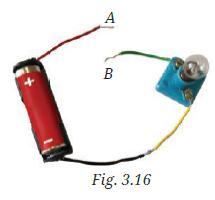
Answer: The lamp will not glow when a non-conducting (insulating) material like wood, plastic, rubber, glass, or paper is connected between A and B.
3. In Fig. 3.17, if the filament of one of the lamps is broken, will the other glow? Justify your answer.

Answer: No, the other lamp will not glow. If one filament is broken in a series circuit, the path for electric current becomes incomplete, so both lamps stop glowing.
4. A student forgot to remove the insulator covering from the connecting wires while making a circuit. If the lamp and the cell are working properly, will the lamp glow?
Answer: No, the lamp will not glow. The plastic insulator prevents the metal wires from conducting electricity, so the circuit remains incomplete.
5. Draw a circuit diagram for a simple torch using symbols for electric components.
Answer: A simple torch circuit includes:
- Battery (2 cells)
- Switch (in ON position)
- Electric lamp
- Connecting wires
Diagram:+| |– -----switch---- lamp ---- | |+ (Use standard symbols from textbook Table 3.2)
6. In Fig. 3.18:
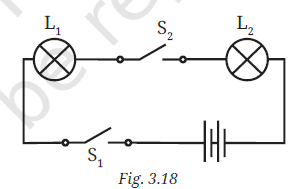
(i) If S2 is ON, S1 is OFF – L2 will glow
(ii) If S2 is OFF, S1 is ON – L1 will glow
(iii) If S1 and S2 are ON – Both L1 and L2 will glow
(iv) If S1 and S2 are OFF – No lamp will glow
Class 7 Electricity: Circuits and their Components
7. Vidyut has made the circuit as shown in Fig. 3.19. Even after closing the circuit, the lamp does not glow. What can be the possible reasons? List as many possible reasons as you can for this faulty operation. What will you do to find out why the lamp did not glow?
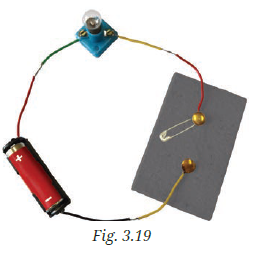
- Cell is drained or not connected properly
- Lamp is fused
- Insulated wires not stripped at ends
- Loose wire connections
- Broken wires
- Switch is faulty or open
- Terminals not connected correctly
What to do:
- Check each component step-by-step
- Use a conduction tester to verify current flow
- Replace cell or lamp if needed
8. In Fig. 3.20, in which case(s) the lamp will not glow when the switch is closed?
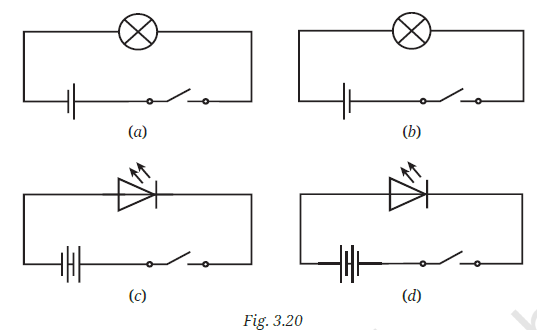
Answer:
- The lamp will not glow in case (c) and case (d)
- Likely due to incorrect terminal connections or broken wires
9. Suppose the ‘+’ and ‘–’ symbols cannot be read on a battery. Suggest a method to identify the terminals.
Answer: Connect the battery to a LED.
- If the LED glows, the longer LED wire is connected to the battery’s positive terminal.
- If it does not glow, reverse the connections to identify the correct polarity.
Class 7 Electricity: Circuits and their Components
10. You are given six cells marked A, B, C, D, E, and F. Some of these are working and some are not. Design an activity to identify which of them are working.
(i) List the items that you require.
(ii) Write the procedure that you will follow.
(iii) With the items, carry out the activity to identify the cells
that are working.
(i) Items needed:
- 1 working lamp
- Connecting wires
- Cell holder or tape
- 6 cells (A to F)
(ii) Procedure:
- Connect each cell one by one with the lamp in a simple circuit.
- Observe whether the lamp glows.
(iii) Conclusion:
- Cells that make the lamp glow are working.
- Others are dead or faulty.
11. An LED requires two cells in series to glow. Tanya made the circuit as shown in Fig. 3.21. Will the lamp glow? If not, draw the wires for correct connections.
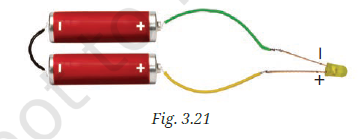
Answer:
No, the lamp will not glow because the LED terminals are connected incorrectly.
Correct connection diagram:
- Positive terminal of battery → longer wire of LED
- Negative terminal of battery → shorter wire of LED
Class 7 Electricity: Circuits and their Components


